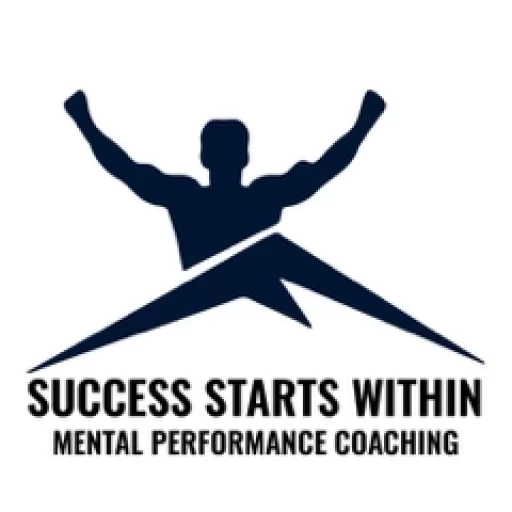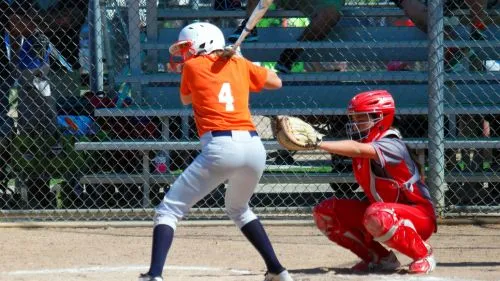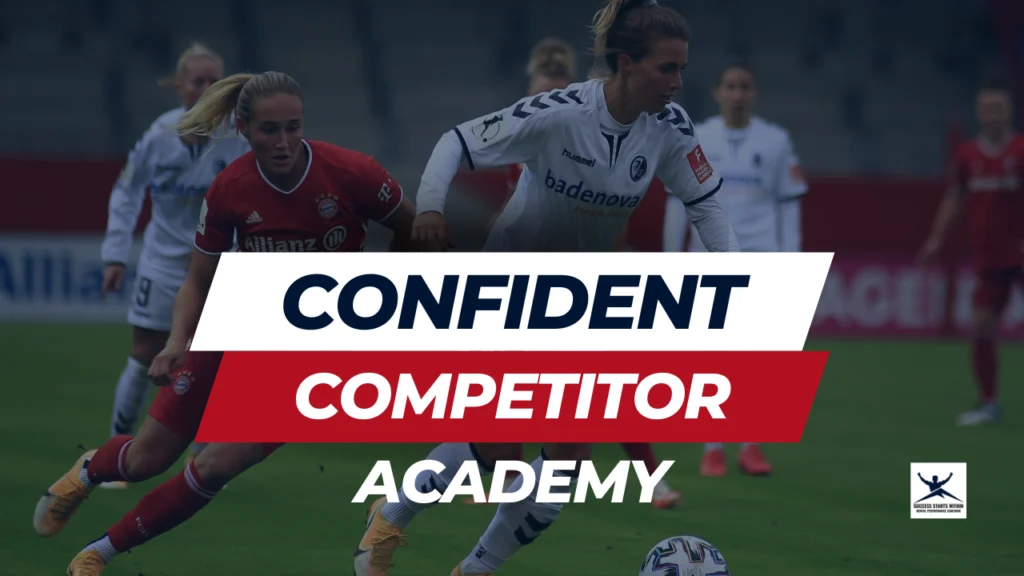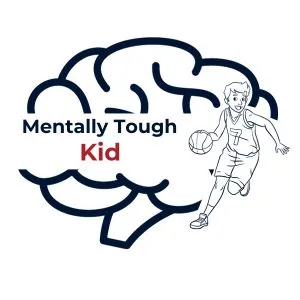There are two main categories of distractions that will impact you as an athlete: internal distractions and external distractions.
In this article, we’re going to discuss these two types of distractions and ways that you can work on managing these distractions during practices and games.
Becoming Aware of Distractions
When we become more aware of our distractions, this builds our self-awareness. And one of the key parts to managing distractions during games is to improve your ability to recognize when you are distracted.
Now, I know that seems pretty simple, right? And I know it seems pretty obvious. But a lot of times when we perform in practice or we perform in a game, we don’t fully realize that we were distracted until after the fact.
We make a mistake and then we’re thinking back over the mistake and we realize, I wasn’t really focused at that point.
We need to work on developing in-the-moment awareness that we are distracted. And when we do so, that takes care of a large part of managing your distractions.
Internal Distractions
The internal distractions that athletes face will involve things like self-doubt, thinking too much about a past mistake, worrying about your stats, or just thinking, If I do make a mistake, my stats will drop, or starting to count what your stats are going to be in your head.
It could also be getting frustrated over a mistake, worrying about how you will play, and a lot of other thoughts just about yourself and your performance.
The key characteristic of internal distractions is that they involve you thinking about something other than the present moment.
Main Internal Dirstractions:
-
Self-doubt
-
Thinking too much about a past mistake
-
Worrying about future performance
-
Focusing on stats or trying to calculate them in your head
-
Getting frustrated after a mistake
-
Worrying about how you will play
-
Negative self-talk or self-criticism
-
Comparing yourself to others
-
Overthinking mechanics or trying to control performance too much
-
Thinking about what others think of you
External Distractions
External distractions involve bad calls, a coach yelling during the game, your teammates making a mistake, maybe bad weather or bad playing conditions, or people watching you who distract you.
Now, obviously, when we look at these external distractions, they are still pulling your attention away from the present moment, but the trigger for this distraction is external — somebody yelling at you, the fans being really loud, or a bad call that you can’t stop thinking about.
It’s something outside of yourself that’s driving you to not be focused.
Main External Dirstractions:
-
Bad calls from referees or umpires
-
Coach yelling during the game
-
Teammates making mistakes
-
Trash talking from opponents
-
Loud fans or crowd noise
-
Poor weather or field conditions
-
Uncomfortable equipment or uniforms
-
Distractions from people watching you (parents, scouts, friends)
-
Scoreboard or game situation pulling focus
-
External pressure or expectations from coaches or parents
Building Awareness and Control
No matter if it’s an internal distraction or an external distraction, we still need to work on controlling our thinking and re-centering ourselves in the present moment.
But as I said earlier, we have to be aware that these are distractions, because we need to be more aware in the moment when we’re focused on them — that is what leads to lower levels of performance.
To help build this awareness, think about your most recent practices and games, and think about the times when you were distracted. Then just write down or outline what was truly distracting you.
-
Were you distracted by your statistics, starting to add up in your head what your stats would look like?
-
Do you get distracted a lot when your coach gives you feedback or yells?
-
Were you really distracted because you were playing against a team that was trash talking?
Developing stronger awareness of what your true distractions are will help you in the moment recognize: Okay, I’m thinking about this thing, and I’ve identified this as one of my main distractions. I need to work right now to refocus myself.
It’s too easy for us to allow ourselves to think about something without realizing that it’s actually distracting us.
A lot of players think that as they go over their stats in their head or think about the last mistake, that’s actually helping them — that it’s an okay thing to think about.
And it could be okay, unless we’ve identified it as one of our main distractions.
So I encourage you to go through that exercise to build awareness and understanding of what truly distracts you.
Refocusing in the Moment
Once we develop that awareness, now we need to work on refocusing ourselves in the moment.
I made a recent article on some resetting techniques that you can go through, and I want to briefly discuss a simple resetting technique.
But before I do, we have to identify the underlying principle we’re always focusing on when it comes to resetting and managing distractions — and that key principle is being present.
I talk a lot about being present within my articles, within my videos, and in my work with athletes.
Being present is so important because when we are distracted, the distraction itself hurts us — it takes our attention away from what’s happening right now, either in practice or during the game.
And what’s happening right now is what’s happening in the present moment.
The more we can remain in the present moment with our focus throughout an entire practice or game, the greater our chances are of performing well and having an effective practice.
So no matter what resetting technique you use, the idea is always to get yourself back focused in the present moment.
The Visual Reset Technique
One of the resetting techniques I discussed in that recent episode was a visual reset.
A baseball player I’ve been working with texted me after he listened to that episode and told me it helped him a lot — he ended up having a great game and actually hit a home run the next game he played.
The visual reset technique was simple:
-
Pause for a moment.
-
Focus on one point on the field (for him, it was the foul pole).
-
Take a deep breath.
-
Remind yourself of your objective — what you want to focus on.
This visual reset helps us take our attention off whatever is distracting us, calm our mind down with the breath, and refocus on our objective to anchor our attention in the present.
Setting Objectives to Stay Present
It’s easy to say “focus on the present moment,” but it’s much harder to actually do.
That’s why I always encourage athletes to set objectives or focus points that keep their attention in the present.
An example I like to use — from about a year and a half ago — was with a younger baseball player I worked with who was about 12.
On a coaching call, I said, “I want you to take about 30 seconds and try to be present right now.”
When he tried, his eyes drifted up to the right-hand corner of the screen. When I asked him what he was looking at, he said, “Well, beyond the computer up there, there’s a chessboard. I was looking at that because it helped me stay in the moment — I was focusing on something in the present moment.”
That’s the idea behind objectives.
If we have a simple objective like focus on the ball, that funnels all of your attention into the present.
When we want to manage distractions, we have to get ourselves to stop thinking about the distractor and refocus on something in the moment.
That’s why you need something concrete to focus on — it could be as simple as your breath, the ball, or the play at hand.
Try to play through your eyes, really directing your attention to wherever you’re looking.
The Long-Term Approach
The last thing I want to mention about managing distractions is that we also have to take a long-term approach.
Managing attention and distractions — whether in sports or life — needs to be an ongoing practice.
That’s why I encourage athletes to take up journaling or mindfulness meditation.
Both develop self-awareness, which makes it easier to recognize when you’ve lost focus, and they train your ability to be in the present moment.
But again, the most important part of managing distractions is simply being aware that you are distracted.
I know that seems obvious, but it’s a lot easier said than done.
We have to develop this awareness of: Okay, I’m distracted by this thing. I need to recognize when I’m focusing on it during play, and then use a resetting technique to bring myself back into the moment.
Final Thoughts
Distractions are one of the biggest mental challenges athletes face, and they fall into two main categories — internal and external.
Internal distractions come from within your own mind, such as self-doubt, overthinking mistakes, worrying about stats, or focusing too much on how you’ll perform. These thoughts pull your attention away from the present moment and lower your ability to compete freely and confidently.
External distractions come from outside sources — like bad calls, a coach yelling, loud fans, or poor playing conditions. While they may feel out of your control, what matters most is how you respond and where you direct your attention afterward.
The key to managing both types is awareness and presence. You must recognize when your mind drifts and then use tools like resetting techniques (deep breaths, visual cues, or simple focus objectives like “watch the ball”) to refocus on the present.
If you’re interested in learning more about my one-on-one mental coaching program, click here to schedule a free introductory coaching call, or fill out the form below.
I’ve also created two online mental training courses for athletes:
And if you’re more of a reader, check out my books:
Thank you for reading and I wish you the best of success in all that you do.




